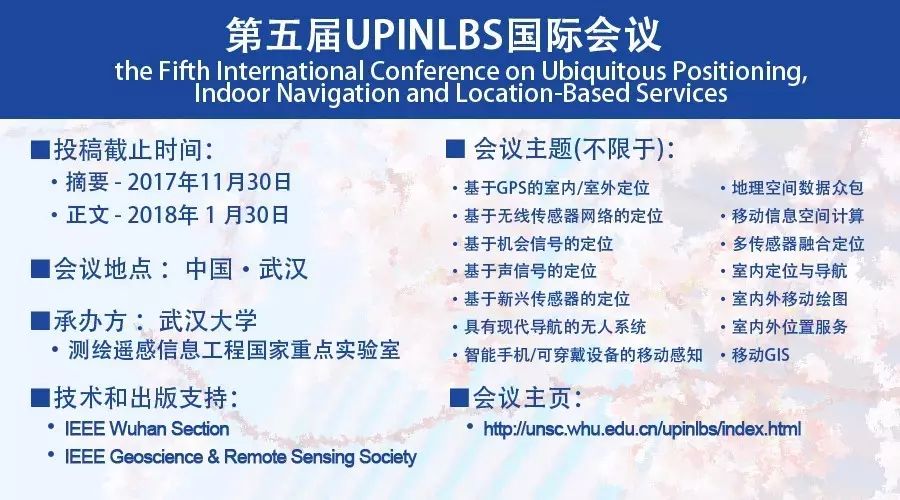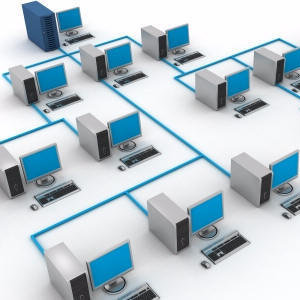【计算机网络类】新增截稿信息6条
计算机网络
ACM Transactions on Internet Technology
Special Section on Fog, Edge, and Cloud Integration for Smart Environments
全文截稿: 2017-12-01
影响因子: 1.489
CCF分类: B类
中科院JCR分区:
• 大类 : 工程技术 - 4区
• 小类 : 计算机:信息系统 - 4区
• 小类 : 计算机:软件工程 - 4区
网址: http://toit.acm.org
An emerging theme that combines elements of cloud computing and the Internet of Things is centered on exploiting the capabilities of embedded smart devices that are closer (geographically and in terms of latency) to users and their decision-making. Fog Computing tries to distribute some of the resources and services of computation, communication, control & storage away from centralized data centers, by exploiting the concept of cloudlets. Edge Computing extends such concept incorporating also IoT devices.
The integration between Cloud, Edge and Fog computing gives rise to research challenges spanning from: design & implementation of mechanisms and policies for device management to issues in the enrollment of mobile devices and users, from trust and identity management in federated environments to distributed data analytics algorithms and frameworks. A central challenge is the effective orchestration of capabilities across edge devices and centralized data centres (which can be multiple hops away from a user).
The objectives of this special section is to focus on novel solutions and innovative approaches that contribute to enhance the synergy between the Cloud, Fog and Edge computing, and the use of these in smart environments and applications (e.g. smart cities, smart homes/building, industry 4.0).
Topics of interest include:
1.Theoretical Foundations
• Modelling languages and notations
• Policy-based provisioning and resource management
• Porting and development of applications & services
• Configuration management and adaptation
• Security: policies, privacy & access control
2.Resource Management Mechanisms
• Devices/infrastructures configuration and management
• Architectures and reference models
• Security, Identity and trust management
• Mobile Crowdsensing
• Performance monitoring & evaluation
• Service placement, migration and adaptation
3.Applications
• Case studies: smart cities, Industry 4.0, smart homes/buildings, intelligent transport, or other areas
• Scalable data analytics & stream processing
• Scenarios demonstrating practical use and deployment
• Revenue-generating applications and services
计算机网络
IEEE Journal on Selected Areas in Communications
Caching for Communication Systems and Networks
全文截稿: 2017-12-01
影响因子: 8.085
CCF分类: A类
中科院JCR分区:
• 大类 : 工程技术 - 2区
• 小类 : 工程:电子与电气 - 1区
• 小类 : 电信学 - 1区
网址: http://www.comsoc.org/jsac
The ever-increasing volume of data traffic and the proliferation of services with stringent performance requirements constantly outpace the capacity upgrades in wired and wireless networks, and challenge their performance and their economic viability. At the same time, recent developments, such as the advent of SDN and NFV technologies, the deployment of multi-tier wireless systems, and the novel interplay of caching with physical layer techniques can create novel opportunities for reducing this demand – supply gap.
In this new era, it is imperative to systematically revisit the role of caching for a variety of reasons: (a) storage becomes an increasingly low-cost resource, in stark contrast with other resources (e.g., spectrum), and can be embedded in equipment of various form factors in large amounts; (b) novel network architectures emerge such as 5G+ systems and hybrid wired-wireless designs; (c) new business models appear with Over-The-Top service providers deploying their own infrastructure or cooperating with network operators; (d) the needs of users are rapidly changing, consuming huge amounts of content on their mobile devices and generating their own content; (e) social networking platforms are heavily affecting network operation creating additional value but also congestion.
Storage and caching can play a fundamental role in this emerging era in communication systems and networks, by increasing the performance of the offered services, reducing operating and capital expenditures, and enabling innovative and game-changing business models. This special issue therefore invites submissions of high-quality original technical and survey papers exploring the role of caching in communication systems and networks, including the following non-exhaustive list of topics:
1.Information-theoretic caching analysis
- Fundamental limits of caching
- Coded caching design with practical constraints
- Receiver and source memory-enhanced communications
- Scaling laws of cache networks
2.Caching in next generation wireless systems
- HetNet and device-to-device caching
- Edge caching, cooperation and femtocaching
- Joint caching with scheduling, routing and utility maximization
- Secure caching, privacy preservation
3.Content caching and delivery
- Design of elastic Content Delivery Networks (CDNs)
- Algorithms for storage installation and content placement
- Novel aspects of video caching and streaming
- Caching economics, collaboration of operators and content providers, OpEx and CapEx analysis, and memory-bandwidth tradeoffs
- Caching models for Information Centric Networking
4.Data analytics for caching
- Analysis of request data, time-varying content popularity models
- Popularity estimation and prediction of viral content
- Machine learning and optimization for popularity incentives
- Interplay of social networks and caching algorithms
计算机网络
Journal of Network and Computer Applications
Special Issue on Scalable Network Infrastructures and Applications for IoT in Smart Cities
全文截稿: 2017-12-15
影响因子: 3.5
CCF分类: C类
中科院JCR分区:
• 大类 : 工程技术 - 3区
• 小类 : 计算机:硬件 - 2区
• 小类 : 计算机:跨学科应用 - 2区
• 小类 : 计算机:软件工程 - 2区
网址: http://www.journals.elsevier.com/journal-of-network-and-computer-applications
The wide adoption of networked, pervasive, and mobile computing systems gave rise to the term of “smart cities,” which nowadays must also imply the ability of sustainable city growth. The Internet-of-Things is a central enabler in this perspective, facilitated by the widespread availability of commodity low-power sensors, partially autonomous actuators and robots, smartphones, tablets, and their wireless connectivity solutions. These elements, combined with i) proper scalable network infrastructures, ii) dynamically extensible software platforms capable of integrating sensors/actuators discovered at runtime, and iii) novel applications capable of stimulating the scalable participation of high numbers of entities widespread in the city, may be utilized to address the challenges of sustainable urban environments.
For example, the extreme scalability constraints envisioned for smart city networking infrastructures, smart city distributed support platforms, and smart city applications on top, are generating challenging technical demands for ultra-low latency, massive connectivity, and high reliability, thus paving the way to the need and widespread adoption of mobile edge computing approaches. Mobile edge computing (or fog computing), in fact, is demonstrating to be able to optimize network infrastructure usage in such challenging scenarios, by dynamically exploiting virtualized resources (allocated network resources, processing functions, and storage space) at computing edges and reducing the need for interworking and continuous connectivity with the global cloud (geographically remote datacenters).
It starts to be recognized that mobile edge computing can play a central and relevant role for the scalability of network infrastructures and applications for IoT in smart cities in the near future. However, the successful employment of mobile edge computing solutions in the field still requires tackling many new and open technical issues. Only to mention some examples, in order to efficiently exploit computation and storage resources at mobile edge nodes, there is the need for joint optimization of dynamic placement of computation/storage resource (also considering stateful/stateless live migration opportunities) and cell-association with radio resource allocation. Such joint optimization should be adaptive according to time-varying environments, e.g., varying wireless channel states and dynamic computation/storage resource utilizations, in their turn depending on users’ mobility, often statistically predictable in terms of patterns that are inferred based on “big monitoring data” originated by the smart city .
In this special issue, articles regarding the use of technologies, methodologies, and applications for scalable smart cities based on the integration of IoT devices and mobile edge computing approaches are invited. Authors are encouraged to submit articles that describe original research and present results that advance the state-of-the-art in the field,
by fueling more related efforts in the future, as well as survey/tutorial manuscripts.
Potential topics of interest include, but are not limited, to the following ones:
- Scalable network infrastructures for smart cities
- IoT architectures, protocols, and algorithms in smart cities
- Enabling technologies for IoT-cloud integration in smart cities
- Ubiquitous sensing and actuation in smart cities, under latency and scalability constraints
- Edge-to-cloud protocols and network architectures for mobile edge computing
- QoE and QoS provisioning in scalable smart city applications
- Crowdsensing and crowdsourcing for scalable IoT in smart cities
- Virtualization and network slicing for mobile edge computing
- Location and sizing of computation and storage elements for mobile edge computing
- 5G/LTE/WiFi-enabled mobile edge computing for scalable IoT
- Real-time online stream processing of IoT datasources for smart cities
- Mobile edge computing for distributed big data analytics
- Smart cities data storage, ownership, and access methods
- Scalable smart city applications for sustainable eco-cities (for environmentally friendly transportation, waste management, eco-friendly buildings, etc.)
- Intelligent transportation systems and vehicular networks
- Smart sharing systems and sharing economy
- Reliability, security, safety, privacy, and trust issues
计算机网络
ICINT 2018
International Conference on Information and Network Technologies
全文截稿: 2017-12-30
开会时间: 2018-05-24
会议难度: ★★
CCF分类: 无
会议地点: Osaka, Japan
网址:http://www.icint.org/
2018 3rd International Conference on Information and Network Technologies (ICINT 2018) aims to provide a forum for researchers, practitioners, and professinals from the industry, academia and government to discourse on research and development, professional practice in information and network technologies. ICINT 2018 will be held in Osaka, Japan during May 24-26, 2018.
ICINT is also the annual meeting of JACN editorial board, so it also serves to bring authors and editors of JACN together to communciate face to face and discuss chances for possible cooperation and future development of JACN.
Publication in Conference Proceedings. Submissions will be peer reviewed by conference committees, and accepted papers will be published in the conference proceedings, which will be indexed by EI Compendex, Scopus, etc.
计算机网络
Networks
Special issue of Networks on “Network based system optimization”
全文截稿: 2018-01-28
影响因子: 1.213
CCF分类: C类
网址: http://onlinelibrary.wiley.com/journal/10.1002/(ISSN)1097-0037
Network based systems are assuming increasing importance in a huge number of applied fields, such as transportation and logistics, computer science, information and communication technologies, critical infrastructure protection, only to cite the most important ones, playing a relevant role in the socio-economic development of a modern society.
This special issue is addressed to scientists and experts from academia and industry, invited to present high quality research papers on methodological and theoretical advances in exact and heuristic optimization methods and their application in network based systems.
Topics of interest include, but they are not limited to:
• Graph Theory and Network Optimization
• Paths and Flow Problems
• Covering, Location and Routing Problems
• Traffic, Transportation and Logistics
• Railway and Maritime Problems
• Critical Infrastructure Protection
• Emergency and Humanitarian Logistics
• ICT and Computer Networks
• Industrial and Territorial Applications
• Emerging applications and practice of OR
计算机网络
ACM Transactions on Internet Technology
Special Section on Advances in Internet-Based Collaborative Technologies
全文截稿: 2018-01-30
影响因子: 1.489
CCF分类: B类
中科院JCR分区:
• 大类 : 工程技术 - 4区
• 小类 : 计算机:信息系统 - 4区
• 小类 : 计算机:软件工程 - 4区
网址: http://toit.acm.org
Individuals, organizations, and government agencies are increasingly relying on Internet-enabled collaboration between distributed teams of humans, computer applications, and autonomous entities such as robots to develop products and deliver services.
Technology trends in areas such as networking, data analytics, and distributed systems have significantly shifted the landscape of Internet based collaborative tools and services. This special section solicits papers describing novel and innovative Internet-based collaborative technologies that benefit from the emerging technologies.
Indicative topics of interest for this special issue include, but are not limited to:
1.Emerging Technology Trend
• Sensor networks and collaborative edges
• Social computing, crowdsourcing, and citizen science
• Internet of Things
• DevOps & agile methodologies
• Autonomic computing
• Fog and edge computing
2.Issues and Challenges
• Security, privacy and trust
• Creation and deployment of mobile services
• Efficient and effective data-intensive computing
• QoS model and management
• Collaboration computing between human and machine
• Resilient and trustworthy Internet
3.Applications, Systems and Platforms
• E-Commerce
• Large scale systems for threat detection
• Internet-enabled large-scale collaborative services
• Context-aware infrastructure and platforms
• Location-aware mobile systems/applications
• Big Data analytics infrastructure and architecture
登录查看更多
相关内容
计算机网络(
Computer Networks )指将地理位置不同的多台计算机及其外部设备,通过通信线路连接起来,在网络操作系统及网络通信协议的管理和协调下,实现资源共享和信息传递的计算机系统。
专知会员服务
9+阅读 · 2019年11月28日
Arxiv
77+阅读 · 2019年11月10日
Arxiv
4+阅读 · 2018年3月15日
Arxiv
4+阅读 · 2018年1月30日






